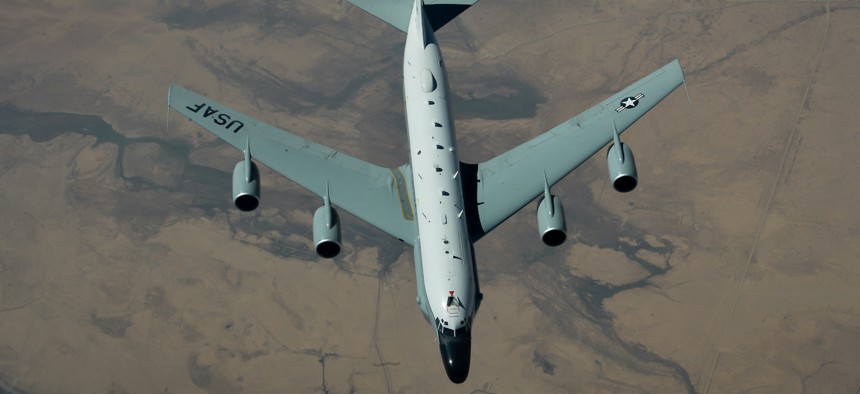
A RC-135V/W Rivet Joint flies above Southwest Asia in 2017. U.S. Air Force / Staff Sgt. Michael Battles
Air Force looks to move spy-plane sensors to satellites
Among the draws: space-based gear can often be built and launched faster than aircraft can be modified.
The Pentagon should consider moving more intelligence-gathering technology from aircraft to less vulnerable spacecraft, a top Air Force general said.
Gen. Mark Kelly, the head of Air Combat Command, spoke as the Pentagon looks for ways to conduct missions that are less susceptible to disruption by advanced Russian and Chinese surface-to-air missiles.
“The force elements that we must send forward to [deploy] today, I'd highly recommend we have a discussion, as an entire force, to put in space tomorrow,” Kelly, who oversees the Air Force’s fighter jets and intelligence planes, said at this week’s Air, Space, and Cyber conference.
The Air Force’s diverse fleet of intelligence planes do a host of missions, including intercepting enemy signals, missile tracking, and tracking ground movements. Many of those aircraft are decades old; some date to the 1960s. While the planes have been overhauled and modernized with newer technology numerous times, they are expensive to fly and are vulnerable to long-range missiles.
They also require large support crews, all positioned at forward operating bases that must have room and board for the airmen, fuel for the planes, defenses, medical evaluation teams, and search-and-rescue assets. A high-flying satellite needs none of that.
“If we've got an ISR capability, a SIGINT capability, an electronic warfare capability, a moving target indicator capability that we can migrate to space, it's a big burden off of our feeding, fueling, protecting, [and] medevacing,” Kelly said.
While Kelly did not name specific aircraft, the Air Force is replacing some of its older planes, such as the E-3 AWACS, with newer, more modern aircraft. At the same time, the Space Force is also buying hundreds of small satellites for missile tracking, communication, and other military functions to augment larger, more expensive ones.
Moving intelligence sensors from planes to satellites is not difficult and in many cases could result in the military getting more modern technology, faster than if the same sensors were installed on a plane, said Ed Zoiss, president of L3Harris Technologies’ Space & Airborne Systems segment.
“It's actually pretty economical to put an airborne sensor into space,” Zoiss said.
Adding a new sensor, like a radar, to an intelligence plane, is typically done when the aircraft goes through what’s known as a block upgrade, he said. Those types of time-intensive upgrades don’t happen often.
“To do a block upgrade on an aircraft takes about six years. To put a sensor in space, we can do it in less than three,” Zoiss said.
By comparison, he said, the Pentagon’s Space Development Agency will launch three new constellations over the next six years.
Just like the aircraft-mounted sensors, the satellites could connect directly to tactical aircraft sharing intelligence.
“Space is the high ground,” Zoiss said. “Space is where the new [unmanned aircraft] will fly because it's a spot where you don't have to worry about being contested other than from other space assets.”
